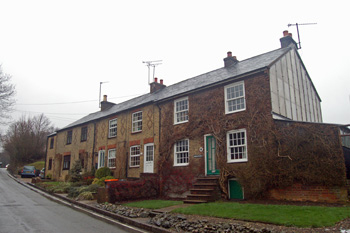Bank Cottages 18 to 26 Dunstable RoadStudham

Bank Cottages January 2010
The 19th century village of Studham was largely a cluster of surviving properties in Dunstable Road. The Rating and Valuation Act 1925 specified that every piece of land and building in the country was to be assessed to determine the rates to be paid on it. Studham was assessed at the end of 1926 and the valuer visiting 18 to 26 Dunstable Road, Bank Cottages, [DV1/C21/6-12] noted that there were then six (and had previously been seven) of them, the two northern most owned by a Miss Allen, the rest by William Gladman.
The various dwellings, running north to south, were described as follows:
- Mrs. Hingley, paying 2/6 per week in rent, the pre-war rent having been 1/9. Accommodation comprised a kitchen and scullery with two bedrooms upstairs. A flint and slate barn and earth closet combined stood outside. There was no garden.
- A vacant property, the rent of which had been 2/6 per week. It also contained a kitchen and scullery downstairs with two bedrooms above, with the same outbuildings and lack of garden. The valuer noted that the house was for sale as of 1st February 1927.
- H. Tearle paid five shillings per week rent, fixed in 1921 (previously 2/9) for a reception room, kitchen and two sculleries downstairs and four bedrooms above. Two brick and corrugated iron barns and earth closets stood outside. Not surprisingly the valuer noted: "Was two cottages before war". Water came from the village well.
- L. Hull paid 1/9 per week rent ("absurd") for a living room and scullery downstairs and two bedrooms above. A brick and corrugated iron barn and earth closet stood outside.
- Mrs. Brandon paid seven shillings a month for a living room and scullery downstairs and two bedrooms above as well as a basement cellar. Outside stood a brick and corrugated iron earth closet. Water came from the village well.
- George Hawkins paid seven shillings a month for identical accommodation to that of Mrs. Brandon.
- J. C. Bears paid 3/6 per week (fixed in 1926) for a basement cellar, reception room and kitchen downstairs and two bedrooms above. A brick and corrugated iron earth closet stood outside.